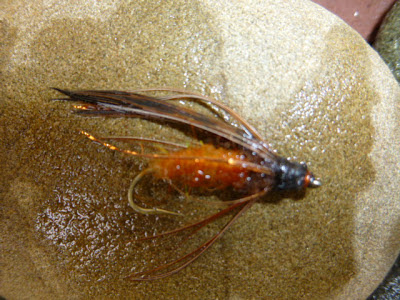 |
| Soft-Hackle Sculpin tied by Steven bird |
Considering the unconventional tying style of the Swing Clown & thinking about attractor patterns for autumn fishing, led me to thinking about the soft-hackle ‘sculpin’ patterns which are good to fish in fall & winter. Tied in natural colorations the shape is suggestive of sculpin, shrimp, crayfish & large nymphs & also offers unlimited possibilities for creating attractor patterns as well.
The basic soft-hackle ‘sculpin style’ as I tie it is formulaic, breaking down thus: A pattern constructed with heavy tailing of layered colors; full-bodied; palmered over the body with shlappen or saddle hackle; a collar of soft hackles (3 or 4 feathers for a Sculpin); a full head of dubbing spun on a loop. I often stack or layer tailing materials, treating the ‘tail’ as an articulation of the body. (I believe the Wooly Booger types work so well in lakes because the marabou tailing simulates the articulated, pulsing abdomen of a dragonfly nymph.) ‘Tailing’ is the simplest way to achieve articulation. Trout & salmon like this design, but it is also a good formula for making killer smallmouth bass patterns.
As with most flies larger than #12, I build the bodies of these on poly sewing thread. Sewing thread builds quicker & takes dubbing better than tying thread. It is stronger & less expensive than tying thread & available in any shade you might want as an undercolor. I cut about 6 feet (a couple arm-lengths) of poly thread from the spool & wrap a layer down the hook shank; wind copper fuse wire over the forward two-thirds of the shank; build a cigar-shaped body; tie in the tailing, ribbing wire & body hackle; then form a dubbing loop & build the body, all with the poly sewing thread. Once the body is wound, I tie in & finish the remaining operations with tying thread.
Hook: #2-#6 TMC 200R
Thread: Black
Tailing: Brownish pheasant rump feather wound as a collar, then tied back & down – two brown partridge, grouse or speckled game hen hackles wound, then tied back & down – topped with a pinch of black marabou or rabbit fur (add a few strands of flash if you like)
Ribbing: Brown or brown dyed grizzly shlappen palmered over the body – reverse wind with copper wire
Body: Patch olive, brown, tan & gray rabbit w/guard hairs onto a yellow dubbing loop
Lateral line: Two strands of copper flash, one on either side of the body
Hackle: Two turns of red, clipped off on top, for gills, then wind a collar of brown partridge or speckled game hen hackles over the front 1/3 of the hook shank
Head: Mix of black, brown & olive rabbit w/guard hairs, wound in a dubbing loop of the tying thread – & finish
The color scheme given here is the pattern I tie for my homewater, though an olive version works better in some places.
The color scheme given here is the pattern I tie for my homewater, though an olive version works better in some places.
 |
| Soft-Hackle Sculpin tied by Steven Bird |
 |
| Ghost Shrimp tied by Steven Bird |
Hook: #4-#8 TMC 200R or steelhead/salmon style
Thread: Orange
Tailing: Orange dyed mallard flank wound as a collar, then tied back & down – top with a pinch of orange marabou
Ribbing: Orange dyed shlappen or saddle hackle palmered over the body – reverse wind with copper wire
Body: Blood red dubbing, wound in a yellow dubbing loop
Hackle: Orange
Head: Red dubbing - & finish.
Head: Red dubbing - & finish.
I weight these with copper fuse wire wound on the hook shank. Sure, they can be tied with bead or cone heads, but then you have a jig. I want a swinging fly, not a jig, don't want it bumping & drilling the bottom, rather, I prefer it tickling its way over the bottom. I rely on a sink-tip or full-sink line with a short leader to get it down.
Flyfish the Upper Columbia/NE Washington with Steven Bird: http://ucflyfishing.blogspot.com
Flyfish the Upper Columbia/NE Washington with Steven Bird: http://ucflyfishing.blogspot.com
















